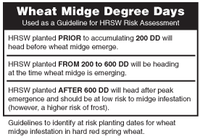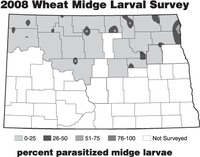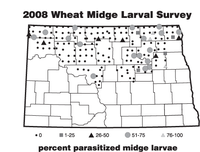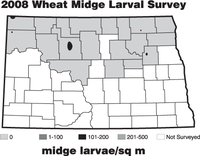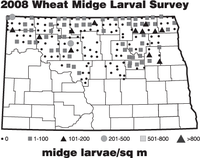Wheat Midge Forecast Looks Favorable for Producers in 2009
(Click an image below to view a high-resolution image that can be downloaded)
A soil survey conducted last year detected decreasing levels of overwintering wheat midge larvae for the 2009 season, according to Janet Knodel, North Dakota State University Extension Service entomologist.
“The 2009 forecast for wheat midge populations continues to be favorable for North Dakota wheat producers,” Knodel says. “Overall, the wheat midge risk is lower than in 2008. Wheat midge populations ranged from zero to 286 midge larvae per square meter, with most of the state having less than 200 midge larvae per square meter during 2008.”
Approximately 60 percent of the soil samples were positive for wheat midge larvae, with an average of 70 larvae per square meter among the positive samples. In contrast, wheat midge populations ranged from zero to 678 midge larvae per square meter, with an average of 107 larvae per square meter, among the positive samples during 2007.
There are two small pockets of 201 to 500 midge larvae per square meter in northwestern Divide and central Ward counties. Areas with more than 200 midge larvae per square meter should be scouted to determine if an action threshold population level exists. However, these areas are not considered high risk (more than 1,200 midge larvae per square meter).
“Field scouts should scout at night when temperatures are greater than 59 degrees and the winds are calm (less than 6 miles per hour) during heading to early flowering crop stages,” Knodel says. “A typical action threshold is one midge per four to five wheat heads for hard red spring wheat and one midge per seven to eight heads for durum when wheat and durum are below $10 per bushel.”
There were no soil samples that were considered a high risk for wheat midge infestation in 2009. At high risk, some control tactic, such as insecticide spraying or planting a nonwheat host, such as canola, soybeans or sunflowers, is recommended to reduce midge populations.
“With a low forecast for wheat midge infestation statewide, an early planting date and planting before 200 accumulated degree days (DD) are an excellent way to mitigate wheat midge damage and to assist parasitism,” Knodel says. “An early planting date is only suitable for hard red spring wheat. This method is not as effective with durum because most durum varieties are later- maturing than spring wheat. By planting early maturing wheat varieties, a midge infestation is minimized because the crop is headed and flowered before the peak adult populations occur.”
Planting early maturing varieties will not help if planting is delayed and occurs during the time that causes the wheat crop to head as the midge is emerging. Degree days also are used to help identify the high-risk planting window for hard red spring wheat. Wheat reaches the heading stage at 1,000 DD when using the same midge DD accumulations (threshold temperature of 40 degrees).
The North Dakota Agricultural Weather Network (NDAWN) can calculate your risk for wheat midge infestation based on your planting date. Go to the NDAWN wheat and wheat midge degree days Web site at http://ndawn.ndsu.nodak.edu/wheat-midgedd-form.html.
“Enter your planting date, select wheat midge degree days and click the submit button to determine which planting window you are in, which are less than 200 DD, 200 to 600 DD or greater than 600 DD,” Knodel says.
The distribution of the parasitic wasp Macroglenes penetrans helps reduce wheat midge populations.
“Unfortunately, the population of parasitic wasps has decreased by half, to an average parasitism rate of 9 percent in 2008 from 16 percent in 2007,” Knodel says. “Parasitism ranged from 0 percent to 100 percent across the state, with the higher rates occurring in areas where midge populations have been high the past few years. About 83 percent of the sites where soil samples were collected had zero parasitism. This trend is indicative of the low populations of wheat midge during the past few years, since the parasitoid population levels follow the wheat midge population levels.”
The wheat midge survey is conducted by the NDSU Extension Service and supported by the North Dakota Wheat Commission.
NDSU Agriculture Communication
| Source: | Janet Knodel, (701) 231-7915, janet.knodel@ndsu.edu |
|---|---|
| Editor: | Rich Mattern, (701) 231-6136, richard.mattern@ndsu.edu |
Attachments
- PDF - Wheat Midge Degree Days - (16.6767578125 kb)
- EPS - Wheat Midge Degree Days - (215.5908203125 kb)
- PDF - 2008 Wheat Midge Larval Survey - all four maps - (40.765625 kb)
- EPS - 2008 Wheat Midge Larval Survey - Percent Parasitized Midge Larvae - (171.259765625 kb)
- EPS - 2008 Wheat Midge Larval Survey - Percent Parasitized Midge Larvae - (282.107421875 kb)
- EPS - 2008 Wheat Midge Larval Survey - Midge Larvae/sq m - (149.12890625 kb)
- EPS - 2008 Wheat Midge Larval Survey - Midge Larvae/sq m - (261.8681640625 kb)

